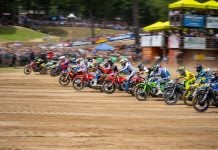AMA ANNOUNCES NEW RULESMAKING COMMITTEES FOR PROFESSIONAL RACING
PICKERINGTON, Ohio — As part of its overall reorganization unveiled today, the American Motorcyclist Association (AMA) has announced the creation of a new rulesmaking procedure for its professional-racing programs.
Direction for the AMA’s professional road racing, motocross/supercross, flat track, supermoto and hillclimb programs has been in the hands of a single AMA Pro Racing Board. That Board will be replaced by independent working committees that will propose equipment standards and rules for on-track competition. Proposed rules would then be ratified by the AMA Board of Directors.
“The goal of this new structure is to allow the Association to be more responsive to all of the groups with an interest in our professional-racing programs,” said AMA Chief Executive Officer Patti DiPietro. “That includes everyone from the manufacturers and team owners to the racers, promoters, aftermarket suppliers and fans.”
The size of these committees will vary depending upon the racing discipline. Each will include one representative from every AMA corporate member manufacturer with a motorcycle homologated for competition in that discipline. In addition, the AMA president will appoint enough other members of the committee to assure that the manufacturers cannot constitute a majority.
In motocross racing, for instance, six manufacturers — Honda, Husqvarna, Kawasaki, KTM, Suzuki and Yamaha — currently have motorcycles homologated for AMA professional competition. The AMA president will appoint at least seven other Motocross/Supercross Committee members, who could include racers, promoters, aftermarket manufacturers and others with an interest in the sport.
These committees will hold at least one formal meeting every year, although it is anticipated that additional, informal meetings may take place more often. Working with representatives from the AMA Pro Racing staff for that discipline, committee members will develop racing rules and equipment standards that will be sent to the AMA Board of Directors.
The AMA Board will have the power to accept or reject the committee’s recommendations, but it will not be allowed to alter those recommendations. A veto by the AMA Board will require support by a supermajority (nine members of the 12-member Board).
Rules that are approved by the AMA Board will not go into effect for at least a full racing season, so that riders and teams will have time to develop their programs. Modifications to rules that are required during the course of a racing season will be handled by an executive committee consisting of chairmen elected by members of each committee. Those rules will apply only for the current racing season. As is the case now, emergency rules changes, if necessary, will be implemented by the AMA Pro Racing staff.
“We are creating a system designed to increase the transparency of the rulesmaking process for AMA professional competition,” said DiPietro. “By opening up these rulesmaking committees to all parties involved in our racing programs, we will make sure that everyone’s voice is heard on these important issues. And we will make public all written reports from the rulesmaking committees to the AMA Board, so that anyone can monitor the process of creating new racing rules.”
Rules for amateur competition run by AMA Sports will continue to be made by the AMA Congress, which brings together representatives from AMA recognized districts across the country each year. As with the new rulesmaking committees for professional racing, the AMA Congress sends its recommendations to the AMA Board for ratification.
The American Motorcyclist Association: rights. riding. racing. Founded in 1924, the AMA is a non-profit organization with more than 270,000 members. The Association’s purpose is to pursue, protect and promote the interests of motorcyclists, while serving the needs of its members. For more information, visit the AMA website at www.AMADirectlink.com, or call 1-800-AMA-JOIN.
More, from another press release issued by AMA:
BACKGROUNDER: AMA ORGANIZATIONAL CHANGES Q & A
-Why is the AMA announcing these changes in structure?
We want to more effectively use the expertise of the members of the AMA Board of Directors while increasing responsiveness to all parts of the motorcycling community.
-What are the structural changes to the AMA Board?
The changes will create three new Board committees devoted to the three core parts of the AMA’s mission: rights, riding and racing. These will be in addition to the Board’s existing Executive and Finance committees. These committees will be composed of existing Board members and may also include outside experts in an advisory role.
-What are the responsibilities of these new committees?
They will be responsible for setting the long-term direction of the Association in those areas, while AMA staff and other groups work on implementation of those long-term decisions.
For instance, in the area of professional racing, the AMA is creating new, independent rulesmaking committees charged with developing equipment standards and on-track rules for road racing, motocross/supercross, flat track, supermoto and hillclimb competition. Working with AMA Pro Racing staff, those independent committees will focus on racing rules, while the AMA Board Racing Committee will focus on long-term strategic planning for the Association’s racing series.
-Who do the new professional-racing rulesmaking committees report to?
The rulesmaking committees will be independent entities charged with developing rules in conjunction with the AMA Pro Racing staff. They will send their proposed rules to the AMA Board’s Racing Committee for review and recommendation. The Racing Committee will forward the proposed rules to the full AMA Board for ratification. The AMA Board Racing Committee will not be directly involved in the rules-development process.
-Who will serve on the new rulesmaking committees?
Committee sizes will be variable. Each committee will include one representative from each AMA corporate member manufacturer with a motorcycle homologated for competition in that discipline. In addition, the AMA president will appoint enough other members of the committee to assure that the manufacturers cannot constitute a majority.
In motocross/supercross racing, for instance, six manufacturers-Honda, Husqvarna, Kawasaki, KTM, Suzuki and Yamaha-currently have motorcycles homologated for AMA professional competition. The AMA president will appoint at least seven other Motocross/Supercross Committee members, who could include racers, promoters, aftermarket manufacturers and others with an interest in the sport.
-How long will those rulesmaking committee members serve?
Terms for rulesmaking committees will be three years. However, if a manufacturer no longer has a motorcycle homologated for that type of competition, it will lose its committee position even if the term has not expired.
-Can AMA Board members serve on rulesmaking committees?
Members of the AMA Board cannot also hold positions on the rulesmaking committees. An AMA corporate member could have a representative elected to the AMA Board and could have representatives on the rulesmaking committees, but the individual who serves on the AMA Board cannot serve on any of the rulesmaking committees.
-How will new racing rules be adopted?
Working with the AMA Pro Racing staff, the rulesmaking committees will develop proposed racing rules and equipment standards that will be sent to the Racing Committee of the AMA Board of Directors for review. The Racing Committee will forward the proposed rules, with its recommendations, to the full AMA Board.
The full AMA Board will have the power to accept or reject the committee’s proposed rules, but it will not be allowed to alter those proposed rules. A veto by the AMA Board will require support by a supermajority (nine members of the 12-member Board).
Rules that are approved by the AMA Board will not go into effect for at least a full racing season, so that riders and teams will have time to develop their programs. Modifications to rules that are required during the course of a racing season will be handled by an executive committee consisting of chairmen elected by members of each committee. Those rules will apply only for the current racing season. As is the case now, emergency rules changes, if necessary, will be implemented by the AMA Pro Racing staff.
-At what point will racers and fans be able to learn about new rules proposals?
All written recommendations from the rulesmaking committees to the AMA Board will be made public.
-Will these new rulesmaking committees determine rules for AMA amateur competition?
No. Amateur competition rules will continue to be developed by the AMA Congress, which includes representatives from AMA recognized districts. As with the new rulesmaking committees for professional racing, the AMA Congress sends its recommendations to the AMA Board for ratification.






